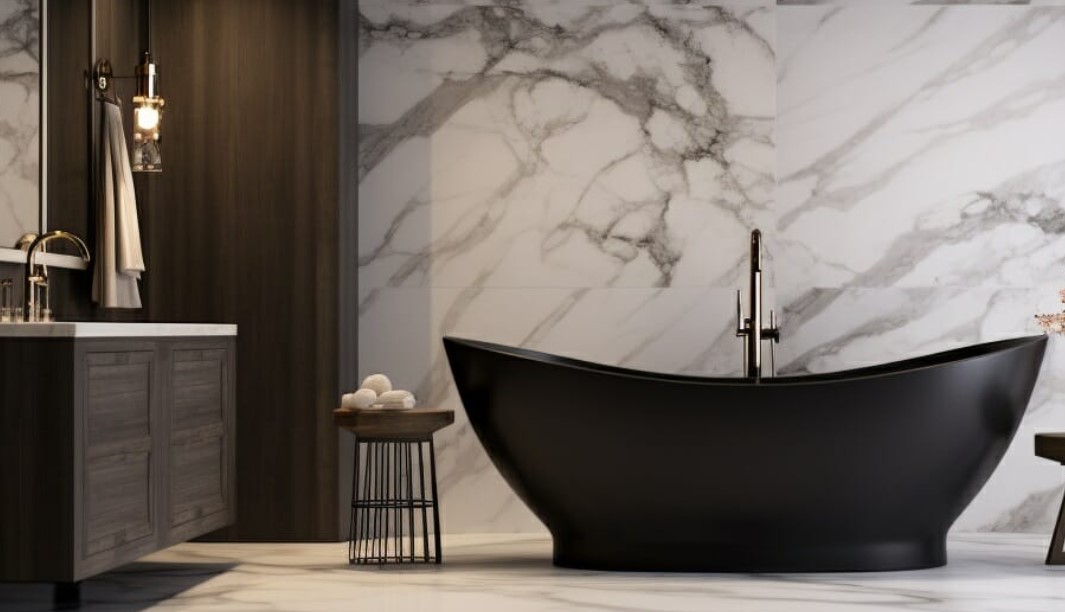As we step into 2024, bathroom design trends continue to evolve, offering innovative ideas for both decoration and layout. The modern bathroom is no longer just a functional space but a sanctuary for relaxation and rejuvenation. In this article, we explore the latest trends in bathroom decoration and layout, highlighting key elements that define contemporary design aesthetics.
Minimalist and Functional Design
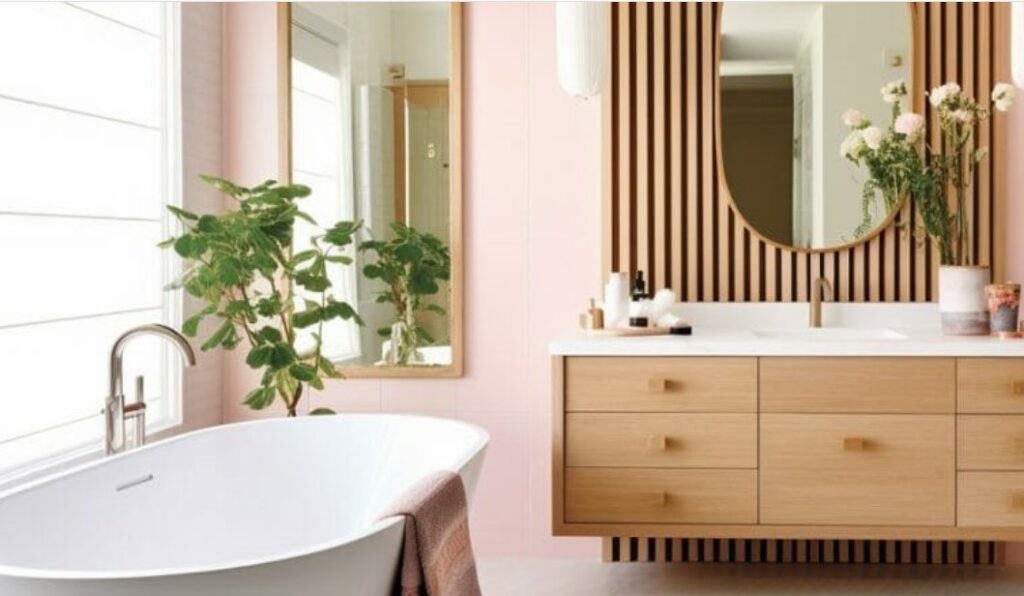
n the realm of bathroom decoration, minimalist and functional design continues to gain prominence as we progress into the latest trends of 2024. Embracing simplicity without sacrificing style, this approach focuses on optimizing space, enhancing usability, and creating a serene atmosphere. Whether you’re renovating a small guest bathroom or revamping a master bath, incorporating minimalist principles can transform your space into a sanctuary of efficiency and elegance.
Key Elements of Minimalist Bathroom Design
1. Clean Lines and Simple Forms
Minimalist bathrooms are characterized by clean lines and simple forms that contribute to a sense of openness and tranquility. Avoiding unnecessary ornamentation, fixtures and furnishings feature sleek, straight edges and geometric shapes. Wall-mounted vanities and floating shelves not only enhance visual spaciousness but also facilitate easier cleaning and maintenance.
2. Neutral Color Palettes
A neutral color palette forms the foundation of minimalist bathroom design. Shades of white, beige, gray, and soft pastels create a calm and soothing environment. These hues reflect natural light, making the space feel brighter and more expansive. Monochromatic schemes or subtle contrasts can be achieved through tiles, cabinetry, and accents, adding depth without overwhelming the minimalist aesthetic.
3. Functional and Efficient Layout
Functionality is paramount in minimalist bathrooms. Thoughtful space planning ensures that every element serves a practical purpose while maintaining a clutter-free appearance. Storage solutions such as recessed cabinets, built-in niches, and under-sink drawers maximize storage capacity without compromising on style. Clear pathways and unobstructed areas further optimize usability and accessibility.
4. High-Quality Materials
In minimalist design, the emphasis is placed on quality over quantity. Selecting high-quality materials such as natural stone, porcelain tiles, and matte finishes enhances the tactile and visual appeal of the bathroom. These materials are not only durable and easy to maintain but also contribute to the overall aesthetic cohesion. Integrating textures like wood grain, concrete, or brushed metal adds subtle interest to the minimalist palette.
5. Integrated Lighting Solutions
Effective lighting is essential in minimalist bathrooms to enhance functionality and ambiance. Strategically placed recessed lights, LED strips, or minimalist fixtures provide adequate illumination without overpowering the space. Dimmable options allow for flexibility in adjusting light levels according to different tasks and moods, from bright task lighting for grooming to soft ambient lighting for relaxation.
Benefits of Minimalist Bathroom Design
1. Enhanced Visual Appeal
Minimalist bathrooms exude a timeless elegance and sophistication that transcends trends. The clean and uncluttered aesthetic creates a sense of calm and order, making the bathroom a tranquil retreat within the home.
2. Improved Functionality and Efficiency
By prioritizing essential elements and optimizing space, minimalist design enhances the usability and efficiency of the bathroom. Streamlined layouts and efficient storage solutions promote organization and ease of maintenance.
3. Increased Relaxation and Well-being
A clutter-free environment fosters relaxation and promotes mental well-being. Minimalist bathrooms with their serene atmosphere and simplified design encourage a sense of peace and tranquility, transforming daily routines into moments of rejuvenation.
Smart Technology Integration
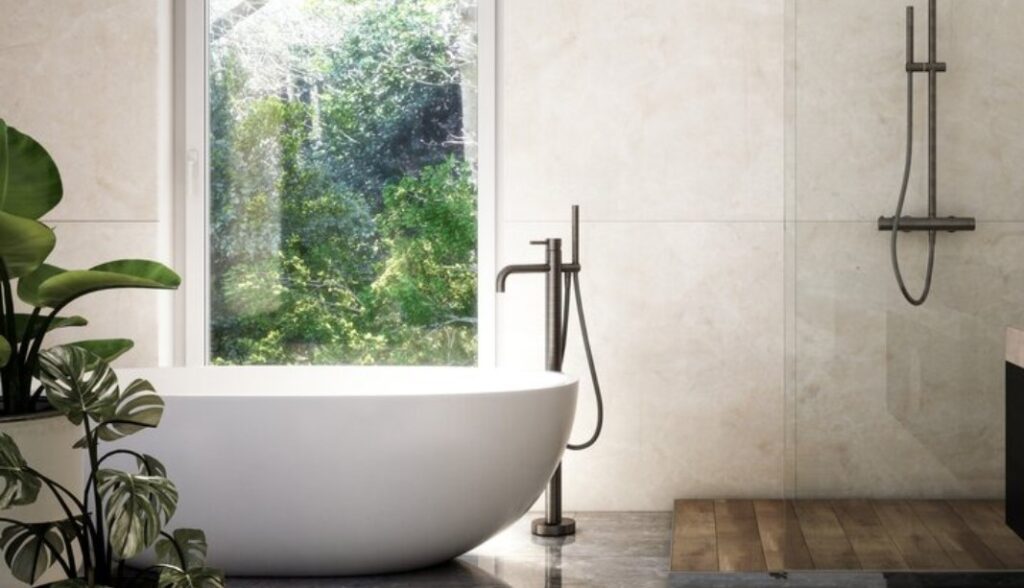
In the era of advanced technology, smart integration has revolutionized every aspect of home design, including the bathroom. As we navigate through the latest trends of 2024, incorporating smart technology into bathroom decoration not only enhances convenience but also elevates the overall functionality and luxury of the space. From intelligent fixtures to automated systems, here’s how smart technology is reshaping bathroom decor.
Key Smart Technologies for the Bathroom
1. Smart Mirrors
Smart mirrors are at the forefront of bathroom innovation, offering functionalities beyond reflection. These mirrors are equipped with integrated touch screens or voice-activated controls, allowing users to access weather updates, news headlines, or adjust lighting and magnification levels. Some models even feature built-in speakers for streaming music or receiving calls, transforming the bathroom into a multimedia hub.
2. Hands-Free Faucets and Fixtures
Hands-free faucets and fixtures promote hygiene and convenience by eliminating the need for physical contact. Motion sensors detect the presence of hands and activate the water flow, reducing water wastage and minimizing the spread of germs. Smart faucets often come with adjustable temperature settings and water-saving modes, contributing to eco-friendly bathroom practices.
3. Smart Toilets
Smart toilets combine comfort, cleanliness, and efficiency through advanced features such as heated seats, bidet functionality, and self-cleaning capabilities. Some models include sensors that automatically open and close the lid, as well as personalized settings for water pressure and temperature control. Integrated deodorizers and air purifiers enhance the bathroom environment, ensuring a pleasant and hygienic experience.
4. Automated Shower Systems
Automated shower systems offer personalized shower experiences tailored to individual preferences. These systems may include programmable controls for water temperature, flow intensity, and shower duration. Users can pre-set their preferred settings through smartphone apps or voice commands, ensuring a consistent and enjoyable shower experience every time.
5. Voice-Activated Controls
Voice-activated controls extend beyond mirrors to encompass entire bathroom environments. Integrated with smart home systems like Alexa or Google Assistant, users can adjust lighting, temperature, and music playlists hands-free. Voice commands simplify daily routines and enhance accessibility, making the bathroom a more user-friendly and interconnected space.
Benefits of Smart Technology Integration
1. Enhanced Convenience and Efficiency
Smart technologies streamline daily tasks and routines, reducing the time and effort required for bathroom maintenance. Automated functions such as self-cleaning toilets and hands-free faucets promote cleanliness while minimizing manual labor.
2. Improved Energy and Water Efficiency
Advanced sensors and programmable settings contribute to energy and water conservation in the bathroom. Smart fixtures optimize water usage by delivering precise amounts according to user needs, while energy-efficient lighting and heating systems reduce overall utility costs.
3. Elevated Comfort and Luxury
The integration of smart technologies enhances the overall comfort and luxury of the bathroom environment. Features like heated floors, adjustable shower settings, and ambient lighting create a personalized spa-like experience at home, promoting relaxation and well-being.
Future Outlook
As technology continues to evolve, the future of bathroom decoration holds exciting possibilities for further innovation. From AI-driven insights to augmented reality experiences, the integration of smart technologies will continue to redefine the way we interact with and experience our living spaces.
Luxurious Materials and Finishes
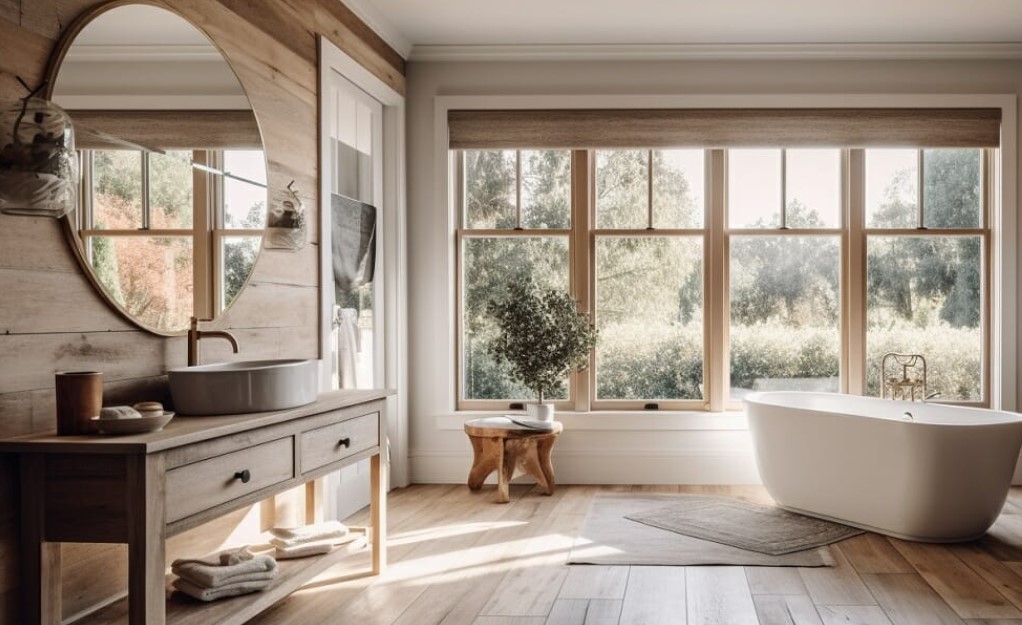
When it comes to creating a luxurious bathroom environment, the choice of materials and finishes plays a crucial role in defining elegance, sophistication, and overall aesthetic appeal. In 2024, homeowners are increasingly drawn to opulent textures, exquisite craftsmanship, and high-end finishes that transform the bathroom into a sanctuary of indulgence and style. Here’s a comprehensive guide to incorporating luxurious materials and finishes into your bathroom decoration.
Exquisite Materials for a Luxurious Bathroom
1. Natural Stone
Natural stone such as marble, granite, and travertine continues to be a hallmark of luxury in bathroom design. These materials boast timeless beauty, unique veining patterns, and a luxurious feel underfoot. Marble, in particular, is prized for its elegance and durability, making it ideal for countertops, flooring, and even accent walls. Granite offers exceptional strength and heat resistance, perfect for vanity tops and shower surrounds.
2. High-Quality Porcelain and Ceramic Tiles
Porcelain and ceramic tiles provide a versatile and durable option for achieving a luxurious look in the bathroom. Available in a wide range of colors, textures, and finishes, these tiles mimic the appearance of natural materials such as marble and wood while offering superior water resistance and easy maintenance. Large-format tiles with minimal grout lines create a seamless and sophisticated appearance, enhancing the perception of space and continuity.
3. Luxury Metals
Luxury metals such as brass, copper, and brushed nickel add a touch of glamour and sophistication to bathroom fixtures and hardware. These materials are not only visually striking but also durable and resistant to corrosion. From faucets and showerheads to towel bars and cabinet hardware, incorporating luxury metals can elevate the overall aesthetic and provide a cohesive design element throughout the bathroom.
4. Glass
Glass is synonymous with modern luxury in bathroom decoration, offering transparency, light reflection, and a sense of openness. Glass shower enclosures, partition walls, and floating shelves enhance visual spaciousness while allowing natural light to penetrate the space. Textured or frosted glass provides privacy without compromising on style, making it a versatile choice for both modern and traditional bathroom designs.
5. Fine Woods and Bamboo
Natural wood and bamboo accents infuse warmth and organic beauty into luxurious bathroom settings. These materials can be used for vanities, shelving units, and accent pieces to create a harmonious balance between natural elements and sophisticated finishes. Wood grains add texture and richness, while bamboo offers sustainability and eco-friendly appeal, making them popular choices among discerning homeowners.
Luxurious Finishes to Enhance Bathroom Elegance
1. Matte and Glossy Finishes
Matte and glossy finishes contribute to the overall aesthetic impact of luxurious bathroom design. Matte surfaces, such as matte black faucets or matte porcelain tiles, offer a contemporary and understated elegance, reducing glare and fingerprints. Glossy finishes, on the other hand, reflect light and create a sense of opulence, particularly in fixtures like polished chrome or glossy ceramic tiles.
2. Polished and Honed Surfaces
Polished surfaces, characterized by their high shine and reflective qualities, impart a sense of luxury and sophistication. Polished marble countertops and polished metal hardware capture and amplify light, creating a luminous effect that enhances the bathroom’s grandeur. Honed surfaces, with their smooth and matte appearance, offer a subtler elegance and tactile appeal, ideal for flooring or accent pieces.
3. Textured Finishes
Textured finishes add depth and tactile interest to bathroom surfaces, creating visual intrigue and a sense of luxury. Textured tiles, such as basket weave patterns or embossed designs, provide a tactile experience while enhancing slip resistance in wet areas. Textured wallpapers or decorative panels can also introduce dimension and personality to the bathroom walls, complementing the overall design scheme.
Benefits of Using Luxurious Materials and Finishes
1. Enhanced Visual Appeal
Luxurious materials and finishes elevate the aesthetic appeal of the bathroom, creating a sophisticated and refined atmosphere. The use of natural stone, luxury metals, and fine woods adds depth, texture, and visual interest, transforming the space into a showcase of elegance and style.
2. Long-Term Durability and Performance
High-quality materials such as natural stone and porcelain tiles are renowned for their durability and resilience in high-moisture environments. Luxury metals and glass are resistant to tarnishing and corrosion, ensuring longevity and minimal maintenance over time. Investing in luxurious materials translates into lasting beauty and functionality, enhancing the overall value of your home.
3. Personalized and Unique Design
Luxurious materials allow for personalized expression and customization in bathroom design. Whether you prefer a classic marble-clad retreat, a contemporary oasis with sleek metals, or a natural-inspired spa sanctuary, the choice of materials and finishes reflects your individual taste and lifestyle preferences.
Sustainable Design Practices
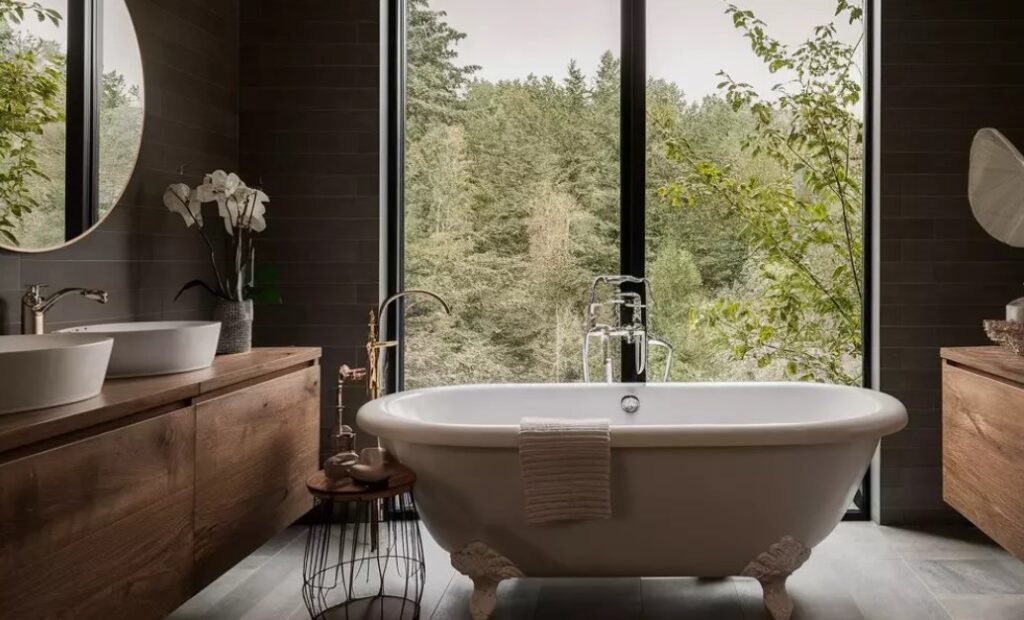
In 2024, sustainable design practices are not just a trend but a necessity, especially when it comes to bathroom decoration. As environmental awareness grows, homeowners are increasingly seeking ways to reduce their ecological footprint while creating stylish and functional living spaces. From eco-friendly materials to water-saving fixtures, here’s how you can incorporate sustainable design practices into your bathroom decor.
Choosing Eco-Friendly Materials
1. Recycled and Upcycled Materials
Opt for bathroom materials that have been recycled or upcycled from post-consumer waste. Recycled glass countertops, tiles made from reclaimed materials, and fixtures crafted from recycled metals contribute to resource conservation and reduce landfill waste. These materials offer unique textures and patterns while promoting environmental stewardship in bathroom design.
2. Sustainable Wood and Bamboo
Choose sustainably sourced wood or bamboo for bathroom vanities, shelving, and flooring. Look for certifications such as Forest Stewardship Council (FSC) to ensure responsible forestry practices. Bamboo, in particular, grows rapidly and is highly renewable, making it an eco-friendly alternative to traditional hardwoods. These materials add warmth and natural beauty to the bathroom while supporting sustainable forest management.
3. Low-VOC and Non-Toxic Finishes
Select paints, sealants, and adhesives that are low in volatile organic compounds (VOCs) and free from harmful chemicals. Low-VOC products improve indoor air quality by minimizing off-gassing, which is beneficial for both occupants and the environment. Choose water-based finishes for cabinetry and walls to reduce environmental impact without compromising on durability or aesthetic appeal.
Water-Saving Fixtures and Appliances
1. High-Efficiency Toilets
Upgrade to high-efficiency toilets (HETs) that use significantly less water per flush compared to older models. Dual-flush toilets offer flexibility in water usage, allowing users to select a full or partial flush depending on waste volume. WaterSense-certified toilets meet EPA criteria for efficiency and performance, further reducing water consumption and lowering utility bills.
2. Low-Flow Showerheads and Faucets
Install low-flow showerheads and faucets that aerate water to maintain pressure while reducing overall flow rates. These fixtures achieve water savings of up to 30% or more without sacrificing shower performance or comfort. Look for WaterSense labels to ensure products meet stringent efficiency standards and contribute to water conservation efforts.
3. Sensor-Activated Faucets
Sensor-activated faucets minimize water waste by automatically turning off when not in use. Motion sensors detect hand movements, activating the water flow and shutting it off when hands are removed. These faucets are ideal for high-traffic bathrooms and public facilities where water conservation is a priority, promoting sustainable practices without compromising hygiene.
Energy-Efficient Lighting and Heating
1. LED Lighting
Replace traditional incandescent bulbs with energy-efficient LED lighting throughout the bathroom. LED bulbs consume less electricity, last longer, and emit minimal heat, reducing energy consumption and cooling costs. Choose fixtures with dimmable options to adjust lighting levels according to tasks and preferences, further optimizing energy efficiency.
2. Solar-Powered Water Heaters
Consider installing a solar-powered water heater to reduce reliance on conventional energy sources and lower utility bills. Solar collectors harness sunlight to heat water stored in a tank or circulated directly through a system, providing sustainable hot water solutions year-round. Solar water heaters contribute to carbon footprint reduction and qualify for renewable energy incentives in many regions.
Designing for Longevity and Adaptability
1. Durable and Easy-to-Maintain Materials
Select durable materials that require minimal maintenance and have a long lifecycle. Porcelain tiles, natural stone, and stainless steel fixtures withstand daily wear and tear while retaining their aesthetic appeal. Investing in quality materials ensures longevity and reduces the need for frequent replacements, supporting sustainable consumption practices.
2. Modular and Flexible Design
Embrace modular design principles that allow for future adaptations and renovations without extensive demolition or waste generation. Choose flexible storage solutions, removable panels, and adjustable fixtures that accommodate changing needs over time. Modular designs promote resource efficiency and facilitate upgrades to enhance functionality and style without starting from scratch.
In 2024, bathroom design trends emphasize functionality, comfort, and sustainability while incorporating innovative technologies and luxurious materials. Whether you prefer a minimalist aesthetic with smart technology integration or a spa-like retreat with natural stone and wellness features, the key is to create a space that enhances both your daily routine and overall well-being. By embracing these trends in decoration and layout, you can transform your bathroom into a stylish sanctuary that reflects modern design sensibilities and enhances the value of your home.
